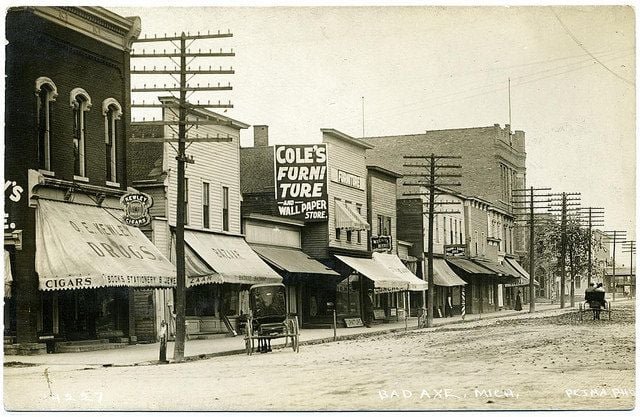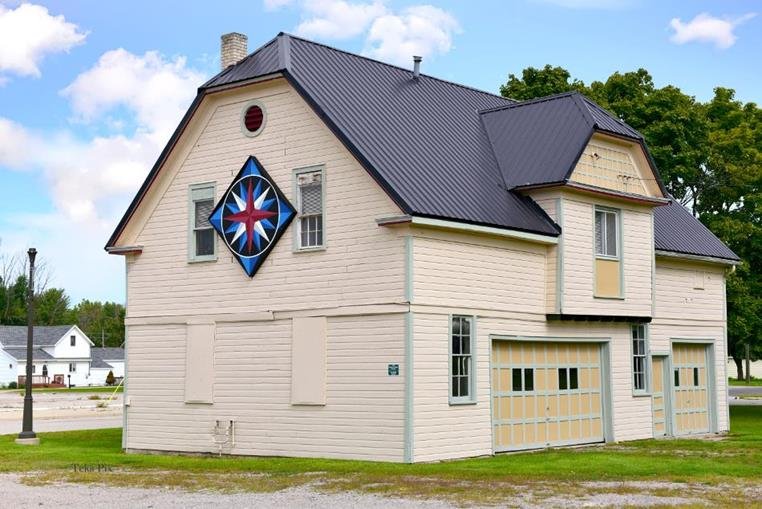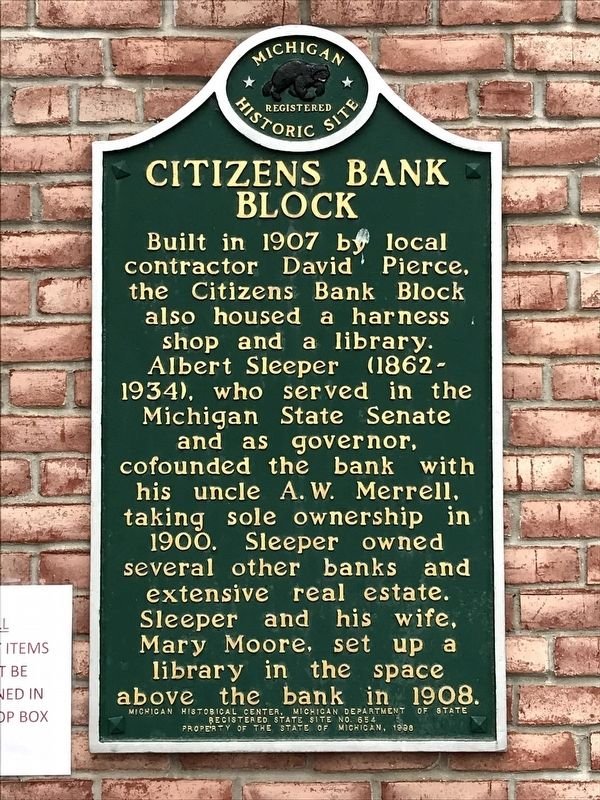
Huron County History
Museums
The Port Austin Reef Light is located in Lake Huron approximately 2½ miles north of the Port Austin Harbor and Port Austin, Michigan. The station was established and first lit in 1878 and after a devastating fire, modified in 1899. It is still operational and acts as an automated beacon to this day.
Enjoy one of the nicest lighthouses on the sunrise side of Lake Huron. Enjoy a short boat ride to the lighthouse and learn about its history from friendly and informative volunteer docents. Guided tours are available on Saturdays in the summer.
The museum preserves and protects the White School Rock Museum and the surrounding area. The museum is set up as a 1909 schoolhouse with authentic materials, and affords educational opportunies and glimpses of the past.
The museum’s collections include student and teacher textbooks, records, and board minutes dating back to the 1800s.
Originally the building was used for many things: court/jury trials, Methodist, Episcopal, Moravian church services, a jail with 2 cells, Charlie Tredup's police office, and a voting place. One side housed a fire engine, meetings, Arbeiter Society, English Baptist congregation, and Tuesday night practice for the Sebewaing Band. In later years Immanuel Church held a rummage sale there. Boy and Girl Scout troops held meetings on the main floor and Jaycee and Jaycettes held meetings on the second floor.
In 1904 a depot was built in Port Hope and a station manager employed. The company decided a few years later that Port Hope was going to be the end of the line up the shore so an engine house, turn around and water tower were built to service the engines.
The Port Austin Area Historical Society operates the Port Austin History Center. The museum, housed in a 1904 Maccabee Society building, presents the history of Port Austin, Grindstone City, and Port Crescent. The grounds feature other historic buildings.
The Pointe aux Barques keeper's house and tower have been completely restored and contain historical artifacts from a bygone era. The Museum is open to the public free of charge and donations are kindly appreciated to help fund the Society's projects.
This historic village is the largest collection of authentically restored pioneer log buildings in Michigan. The six individual museums include a pioneer home, general store, one room school, chapel, barn and a blacksmith shop. They were originally built between 1875 and 1900 and moved to this site from elsewhere around Huron County, Michigan, in the 1980’s. Each contain period artifacts and antiques that let the visitor step back in time and look into this area’s past.
The Depot Museum, as it is often referred to, occupies the former Pigeon Depot which was built in 1908 as a joint venture of the Pontiac, Oxford and Northern and the Pere Marquette Railroads. Today it contains over 2000 artifacts from past Pigeon businesses and the people who lived here. See the clothes they wore, the tools they worked with and how their homes may have looked.
Housed within the historic Maccabees hall, Caseville Museum strives to offer visitors an opportunity to trace the city's history through its immersive displays. Established in 2008, the museum is managed by the Historical Society of Caseville, which aims to promote an understanding of the area's culture and traditions.
The Luckhard Museum is a mission that was built for teaching the gospel to the American Indians in 1845. It houses pioneer & Indian relics.
Working to collect and preserve the past history of the village of Elkton and the surrounding area. Also to pass on the history of said area and educate the future generations.
Huron City had its start as a lumber town in 1854 founded by Langdon Hubbard. His descendants are keeping the history alive caring for the buildings and the things he left behind through the William Lyon Phelps Foundation.
Step through time into Grice House, which has been furnished entirely by donated items from numerous area families to depict life in this part of Michigan in the 19th and early 20th centuries.
Visit the Frank Murphy Memorial Museum and learn more about the life and times of Frank Murphy and how he helped shape Michigan, the United States, and even the Philippines!
In 2006 the home became available just ahead of the wrecking ball. The Sebewaing Area Historical Society took on the restoration of the home. The woodwork, light fixtures, and hardwood floors are original and in great condition.
We are the historical society of Bay Port Michigan. We want to tell people about history of Bay Port
This 1902 Dutch colonial home was built by Wallace E. Allen, the town’s longest serving mayor. The home was owned by only one family and is nearly unchanged from its original configuration. Many of the homes original features are still as they were in 1902. The home is furnished with period antiques throughout.
Historical Markers
Named after a boulder in Lake Huron that was used as a landmark in the Indian Treaty of 1807, the village was settled about 1860. Destroyed in the Great Fire of 1871, the town was soon rebuilt, including a schoolhouse. The present building was constructed in 1909.
On July 1, 1845, three Lutheran missionaries, Reverend Johann J. F. Auch, Reverend J. Simon Dumser, and Reverend George Sinke, arrived to evangelize the Chippewa Indians. A log chapel was built here later that summer.
Stagecoaches played an important part in developing the Midwest. Michigan’s frontier “fever” peaked in the decade from 1830 to 1840 with a 600 percent population increase. Stagecoaches attempted to fill the demand for fast and relatively comfortable transportation.
The Polish refugees who immigrated to Dwight Township in the 1840s in order to escape Prussian domination worshipped at St. Michael’s Catholic Church in Port Austin. In 1903, in an effort to retain their Polish identity, they established their own parish and built St. Mary of Czestochowa Church, named for “the Queen of Poland.”
Sebewaing Township was organized in 1853. In 1877 the board resolved to use “liquor money” to build this township hall. The atypical two-story town hall included voting booths, a courtroom, a jury room, a jail, and a meeting hall.
This chimney was built in 1858 by John Geltz. It is all that remains of the lumber mill established that year by William R. Stafford. Port Hope grew up around the mill. For a score of years, this town was a center of lumbering in the Thumb. It also became an important producer of salt.
The Pointe aux Barques Lighthouse and Lifesaving Station aided mariners for over a century, beginning in 1847. That year the U.S. Lighthouse Service built the first lighthouse on this site to mark the turning point of Lake Huron into Saginaw Bay and to warn of shallow waters.
The Pigeon Depot was constructed in 1908 and served two railroad lines. In 1883 the Pontiac, Oxford, and Port Austin Railroad, a north-south line, had been extended to Caseville and a depot was built at Berne, one mile north of here.
In 1882, as three new railroads began to lay track in Huron County, two cousins from Saginaw, John G., and John S. Owen, bought land in the Columbia Swamp. The following year, they opened a sawmill to harvest the native oak.
In 1868 the Reverend Manasseh Hickey and twelve settlers organized a Methodist Episcopal church in Caseville. Services were held in a schoolhouse until the present church was built. Upon its dedication on November 15, 1874, the Gothic-inspired structure, with its 70-foot-high steeple, became a focal point for the community.
One of Sebewaing’s most prominent citizens, John C. Liken (1832-1920) came here in 1865 from New York State lured by Michigan’s bountiful forests, he opened stave and sawmills in Sebewaing, Unionville, Akron, and Fairgrove. His firm, John C. Liken and Company, dealt in a variety of commodities that the company’s fleet of ships transported to Bay City and markets in New York.
During the mid-1850s the firm of R. B. Hubbard and Company, which included Connecticut-born entrepreneurs Langdon Hubbard, his brother Watson, and cousin Rollin B., built a steam-powered sawmill on Willow Creek. The company town they developed was named Huron City in 1861.
Small fires were burning in the forests of the Thumb, tinder-dry after a long, hot summer, when a gale swept in from the southwest on September 5, 1881. Fanned into an inferno, the fires raged for three days. A million acres were devastated in Sanilac and Huron Counties alone.
Frank Murphy was Associate Justice of the U. S. Supreme Court from 1940 until his death in 1949. His earlier career included service as a Judge in the Detroit Recorder’s Court and instructor in law at the University of Detroit in the twenties. In the following decade, he was Mayor of Detroit, U. S. Governor-General in the Philippines, Governor of Michigan, and Attorney General of the United States.
Built in 1907 by local contractor David Pierce, the Citizens Bank Block also housed a harness shop and a library. Albert Sleeper (1862-1934), who served in the Michigan State Senate and as governor, co-founded the bank with his uncle A. W. Merrell, taking sole ownership in 1900. Sleeper owned several other banks and extensive real estate.
Around 1857 Charles G. Learned purchased several thousand acres of pine land in Michigan’s Thumb area. With profits from his lumbering and farming enterprises, Learned enlarged and updated this house in the French Second Empire style. In the 1860s Ohio congressman, later president, James A. Garfield, a family friend, was a frequent guest here.


































